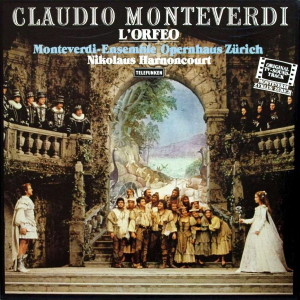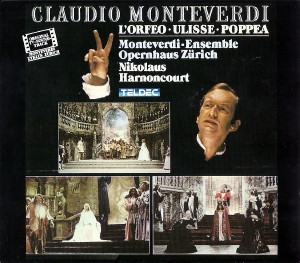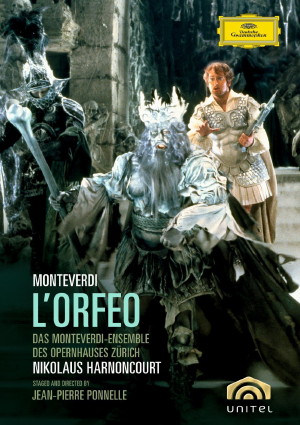 |
2 LP -
6.35591 EK - (p) 1981
|

|
| 6 CD -
8.35807 XB - (c) 1988 |
 |
| 1 DVD -
0440 073 4163 6 (c) 2007 |
|
Claudio
Monteverdi (1567-1643)
|
|
|
|
|
|
|
|
| L'Orfeo |
|
|
|
|
|
|
|
Toccata
|
|
0' 37" |
A1 |
| Prologo |
|
4' 44" |
|
| - "Dal mio Parnasso amato" |
4' 44" |
|
A2 |
| Atto Primo |
|
15' 47" |
|
| - "In questo lieto e fortunato
giorno" |
15' 47" |
|
A3 |
| Atto Secondo |
|
23' 23" |
|
| - "Ecco pur ch'a voi ritorno" |
5' 54" |
|
A4 |
| - "Mira, deh mira Orfeo" |
17' 29" |
|
B1 |
| Atto Terzo |
|
25' 31" |
|
| - "Scorto da te, mio nume" |
7' 31" |
|
B2 |
| - "Possente spirto e formidabil
nume" |
18' 00" |
|
C1 |
| Atto Quarto |
|
15' 25" |
|
| - "Signor, quell'infelice" |
6' 53" |
|
C2 |
| - "Qual onor di te fia degno" |
8' 32" |
|
D1 |
| Atto Quinto |
|
14' 30" |
|
| - "Questi i Campi di Tracia" |
14' 30" |
|
D2 |
|
|
|
|
| Philippe
Huttenlocher, Orfeo |
Roland
Hermann, Apollo |
|
Rachel
Yakar, Euridice
|
Suzanne
Calabro, Ninfa |
|
Trudeliese
Schmidt, Speranza, La
Musica
|
Peter
Keller, Pastore 1 |
|
| Glenys
Linos, Messaggera,
Proserpina |
Francisco
Araiza, Pastore 2, Spirito
1 |
|
| Hans
Franzen, Caronte |
Rudolf
A. Hartmann, Pastore 3,
Spirito 2 |
|
| Werner
Gröschel, Plutone |
Jozsef
Dene, Pastore 4, Spirito 3 |
|
|
|
| Chor des
Opernhauses, Zürich, Pastori,
spiriti e ninfe |
|
Monteverdi-Ensemble
Opernaus Zürich
|
|
|
|
| Nikolaus
Harnoncourt, Gesamtleitung |
|
|
|
Luogo e data
di registrazione
|
| Neue Kirche
Altstetten & Neuw
Kirche Albisrieden,
Zurigo (Svizzera)
- dicembre 1977 |
|
Registrazione
live / studio
|
| studio |
Producer / Engineer
|
Original Soundtrack Unitel
Film & TV Production
|
Prima Edizione
CD
|
Teldec - 8.35807 XB - (6
cd) - 70' 04" + 70' 56" + 64' 22" + 72'
24" + 69' 23" + 62' 18" - (c) 1988 - AAD
|
Prima
Edizione LP
|
Telefunken - 6.35591 EK - (2
lp) - 51' 57" + 47' 55" - (p) 1981
|
Edizione DVD
|
Deutsche Grammophon - 0440 073
4163 6 - (1 dvd) - 101" 00" - (c) 2007 -
(IT) GB-DE-FR-SP-CH
|
|
|
L'ORFEO
|
With “Orfeo”, the
first definitive opera in musical
history, Monteverdi
created for the court of Mantua in
1607 a work of art in which poetry and
music form a musical-dramatic unit. In
this work he ingeniously fused the new
recitative-dramatic style with the
traditional forms of the Renaissance
intermedio. The colourful sound
palette of the rich instrumental
combination not only supports the solo
and ensemble passages, but also, by
means of numerous independent pieces,
plays a connecting and bridging role
in the course of events on the stage.
In the score printed in 1609
Monteverdi differentiates between
fundamental and ornamental
instruments. The former (chitarrone,
lute, harp, harpsichord, regal and
others) are responsible for
the harmonic fill-in of the bass
part, while the mostly paired
ornamental instruments
(predominantly wind and strings) are
principally concerned with
characterising the two spheres of
the opera, the shepherds and the
underworld, and their personae. The
title role is mainly accompanied by
the harp, the shepherds are couched
in the sound of flutes, harpsichord
and lute, while the gods of the
underworld are emphasized with trombones and regal.
The opera leads after the short
prologue, which at the same time
provides the tone setting for the
title, into the first act. Orpheus
has returned and is united with
Eurydice. Shepherds and nymphs
strike up songs of joy and thanksgiving. The focal
point of this idyll is the duet of
the loving couple expressing their
radiant bliss. This gay basic mood
is intensified in the ballet scenes
at the beginning of the second act.
Orpheus and the shepherds intone
dance songs in the style of the Italian balletti and
French examples, frequently
interrupted by dancelike
instrumental ritornelli. The scene
abruptly changes: a girl messenger
tells with halting voice of the
death of Eurydice.
The lamentation song of Orpheus,
overcome with pain and sorrow, is
one of the most touching solos in
the entire opera. The “Tu se’ morta,
mia vita” begins pianissimo above
restrained organ tones and ends with
the last farewell "A
dio terra; a dio, cielo, e sole, a
dio". In this
passage Monteverdi has in masterly
fashion set out all the stages of
despair, using hard dissonances,
abrupt changes of key and
fluctuating, strongly expressive
melody. The pungent
mourning chorus of the nymphs and
shepherds which concludes the act
takes up the general plaintive mood.
In the third act,
Orhpeus leaves for the underworld to
reclaim Eurydice, initially
accompanied by La Speranza, Hope,
who however leaves him at the gates
of the realm of spirits. With the
power of music, a coloratura aria
forming the crucial point of the
action, Orpheus tries to get past
the stolid guard Caron, at first in
vain. However, he finally reaches
his goal, where wild choruses of
furies terrify him. In the fourth act
Proserpina, moved by Orpheus’ music,
asks her husband Pluto to release
Eurydice. Her song, filled with deep
feeling and sympathetic warmth, is
in strange contrast to the
impersonal coldness of the world of
shadows. Pluto finally agrees, but
on the strict conditions that the
lovers should not glance at each
other hetore they leave his domain.
The music of the underworld now also
takes on more human traits. The
chorus of spirits in lively changes
of rhythm of compassion and love,
while Orpheus, in a dancing, zestful
mood, praises the power of music. In
the succeeding confrontation scene
with Eurydice, characterized by a
highly dramatic recitative, Orpheus
fails to pass the difficult test:
overwhelmed by his feelings, he turns to gaze on
his loved one, thereby losing her
for ever. The touching lamentation song of
the lovers, and the powerful fateful chorus of the
spirits of hades, moralising on thc
virtue of self-discipline, conclude
this act.
The tragic end of the fable, in
which Orpheus is torn apart by
raging maenads, was not a satisfying
one during Monteverdi’s time. At
this point Apollo appears instead as
deus ex machina. He takes Orpheus
away to Parnassus, where he will see
Eurydice again in the sun and the
stars. With an artistically set duet
form coloratura song the two fly
away, to the accompaniment of harp
music. The “favola in musica” ends
on earth: the chorus lauds with
sparkling dance rhythms Orpheus’
decision, while a moresca leads on
to a joyful dance.
|
|
Nikolaus
Harnoncourt (1929-2016)
|

|

|
|